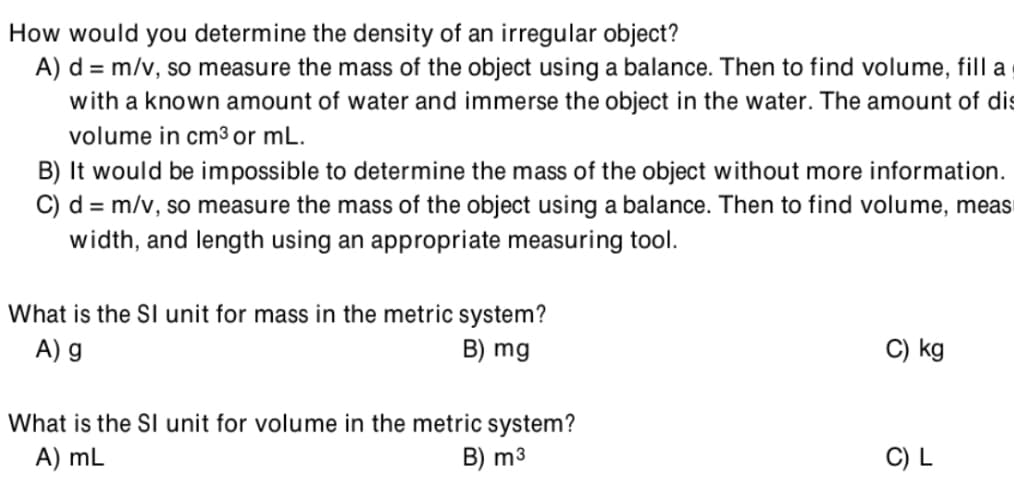How would you determine the density of an irregular object? A) d = m/v, so measure the mass of the object using a balance. Then to find volume, fill a with a known amount of water and immerse the object in the water. The amount of dis volume in cm3 or mL. B) It would be impossible to determine the mass of the object without more information. C) d = m/v, so measure the mass of the object using a balance. Then to find volume, meas width, and length using an appropriate measuring tool. What is the SI unit for mass in the metric system? A) g B) mg C) kg What is the SI unit for volume in the metric system? A) mL B) m3 C) L
How would you determine the density of an irregular object? A) d = m/v, so measure the mass of the object using a balance. Then to find volume, fill a with a known amount of water and immerse the object in the water. The amount of dis volume in cm3 or mL. B) It would be impossible to determine the mass of the object without more information. C) d = m/v, so measure the mass of the object using a balance. Then to find volume, meas width, and length using an appropriate measuring tool. What is the SI unit for mass in the metric system? A) g B) mg C) kg What is the SI unit for volume in the metric system? A) mL B) m3 C) L
Chemistry by OpenStax (2015-05-04)
1st Edition
ISBN:9781938168390
Author:Klaus Theopold, Richard H Langley, Paul Flowers, William R. Robinson, Mark Blaser
Publisher:Klaus Theopold, Richard H Langley, Paul Flowers, William R. Robinson, Mark Blaser
Chapter1: Essential Ideas
Section: Chapter Questions
Problem 42E: Visit this PhET density simulation (http://openstaxcollege.org/l/16phetmasvolden) and select Custom...
Related questions
Question

Transcribed Image Text:How would you determine the density of an irregular object?
A) d = m/v, so measure the mass of the object using a balance. Then to find volume, filla
with a known amount of water and immerse the object in the water. The amount of dis
volume in cm3 or mL.
B) It would be impossible to determine the mass of the object without more information.
C) d = m/v, so measure the mass of the object using a balance. Then to find volume, meas
width, and length using an appropriate measuring tool.
What is the SI unit for mass in the metric system?
A) g
B) mg
C) kg
What is the SI unit for volume in the metric system?
B) m3
A) mL
C) L
Expert Solution
This question has been solved!
Explore an expertly crafted, step-by-step solution for a thorough understanding of key concepts.
This is a popular solution!
Trending now
This is a popular solution!
Step by step
Solved in 2 steps

Knowledge Booster
Learn more about
Need a deep-dive on the concept behind this application? Look no further. Learn more about this topic, chemistry and related others by exploring similar questions and additional content below.Recommended textbooks for you

Chemistry by OpenStax (2015-05-04)
Chemistry
ISBN:
9781938168390
Author:
Klaus Theopold, Richard H Langley, Paul Flowers, William R. Robinson, Mark Blaser
Publisher:
OpenStax

Chemistry
Chemistry
ISBN:
9781305957404
Author:
Steven S. Zumdahl, Susan A. Zumdahl, Donald J. DeCoste
Publisher:
Cengage Learning


Chemistry by OpenStax (2015-05-04)
Chemistry
ISBN:
9781938168390
Author:
Klaus Theopold, Richard H Langley, Paul Flowers, William R. Robinson, Mark Blaser
Publisher:
OpenStax

Chemistry
Chemistry
ISBN:
9781305957404
Author:
Steven S. Zumdahl, Susan A. Zumdahl, Donald J. DeCoste
Publisher:
Cengage Learning


Chemistry & Chemical Reactivity
Chemistry
ISBN:
9781337399074
Author:
John C. Kotz, Paul M. Treichel, John Townsend, David Treichel
Publisher:
Cengage Learning

Chemistry: Principles and Practice
Chemistry
ISBN:
9780534420123
Author:
Daniel L. Reger, Scott R. Goode, David W. Ball, Edward Mercer
Publisher:
Cengage Learning

Chemistry: Matter and Change
Chemistry
ISBN:
9780078746376
Author:
Dinah Zike, Laurel Dingrando, Nicholas Hainen, Cheryl Wistrom
Publisher:
Glencoe/McGraw-Hill School Pub Co